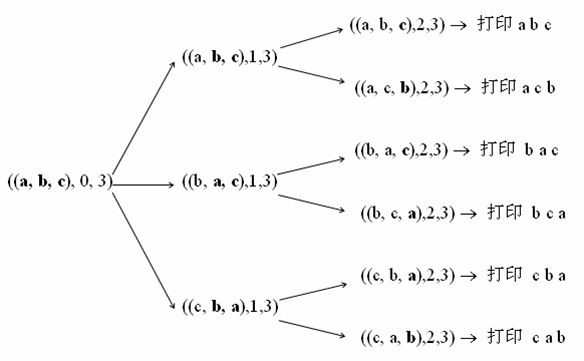题目:输入一个字符串,打印出该字符串中字符的所有排列。例如输入字符串abc,则输出由字符a、b、c所能排列出来的所有字符串abc、acb、bac、bca、cab和cba。
分析:这是一道很好的考查对递归理解的编程题,因此在过去一年中频繁出现在各大公司的面试、笔试题中。
我们以三个字符abc为例来分析一下求字符串排列的过程。首先我们固定第一个字符a,求后面两个字符bc的排列。当两个字符bc的排列求好之后,我们把第一个字符a和后面的b交换,得到bac,接着我们固定第一个字符b,求后面两个字符ac的排列。现在是把c放到第一位置的时候了。记住前面我们已经把原先的第一个字符a和后面的b做了交换,为了保证这次c仍然是和原先处在第一位置的a交换,我们在拿c和第一个字符交换之前,先要把b和a交换回来。在交换b和a之后,再拿c和处在第一位置的a进行交换,得到cba。我们再次固定第一个字符c,求后面两个字符b、a的排列。
既然我们已经知道怎么求三个字符的排列,那么固定第一个字符之后求后面两个字符的排列,就是典型的递归思路了。
基于前面的分析,我们可以得到如下的参考代码:
void Permutation(char* pStr, char* pBegin);
/
// Get the permutation of a string,
// for example, input string abc, its permutation is
// abc acb bac bca cba cab
/
void Permutation(char* pStr)
{
Permutation(pStr, pStr);
}
/
// Print the permutation of a string,
// Input: pStr - input string
// pBegin - points to the begin char of string
// which we want to permutate in this recursion
/
void Permutation(char* pStr, char* pBegin)
{
if(!pStr || !pBegin)
return;
// if pBegin points to the end of string,
// this round of permutation is finished,
// print the permuted string
if(*pBegin == '/0')
{
printf("%s/n", pStr);
}
// otherwise, permute string
else
{
for(char* pCh = pBegin; *pCh != '/0'; ++ pCh)
{
// swap pCh and pBegin
char temp = *pCh;
*pCh = *pBegin;
*pBegin = temp;
Permutation(pStr, pBegin + 1);
// restore pCh and pBegin
temp = *pCh;
*pCh = *pBegin;
*pBegin = temp;
}
}
}
扩展1:如果不是求字符的所有排列,而是求字符的所有组合,应该怎么办呢?当输入的字符串中含有相同的字符串时,相同的字符交换位置是不同的排列,但是同一个组合。举个例子,如果输入aaa,那么它的排列是6个aaa,但对应的组合只有一个。
扩展2:输入一个含有8个数字的数组,判断有没有可能把这8个数字分别放到正方体的8个顶点上,使得正方体上三组相对的面上的4个顶点的和相等。
#include <stdio.h>
#include <string.h>
#include <stdlib.h>
void f(char *str, int len, int n)
{
}
int main(int argc, char **argv)
{
}
分析:这是一道很好的考查对递归理解的编程题,因此在过去一年中频繁出现在各大公司的面试、笔试题中。
我们以三个字符abc为例来分析一下求字符串排列的过程。首先我们固定第一个字符a,求后面两个字符bc的排列。当两个字符bc的排列求好之后,我们把第一个字符a和后面的b交换,得到bac,接着我们固定第一个字符b,求后面两个字符ac的排列。现在是把c放到第一位置的时候了。记住前面我们已经把原先的第一个字符a和后面的b做了交换,为了保证这次c仍然是和原先处在第一位置的a交换,我们在拿c和第一个字符交换之前,先要把b和a交换回来。在交换b和a之后,再拿c和处在第一位置的a进行交换,得到cba。我们再次固定第一个字符c,求后面两个字符b、a的排列。
既然我们已经知道怎么求三个字符的排列,那么固定第一个字符之后求后面两个字符的排列,就是典型的递归思路了。
基于前面的分析,我们可以得到如下的参考代码:
void Permutation(char* pStr, char* pBegin);
/
// Get the permutation of a string,
// for example, input string abc, its permutation is
// abc acb bac bca cba cab
/
void Permutation(char* pStr)
{
Permutation(pStr, pStr);
}
/
// Print the permutation of a string,
// Input: pStr - input string
// pBegin - points to the begin char of string
// which we want to permutate in this recursion
/
void Permutation(char* pStr, char* pBegin)
{
if(!pStr || !pBegin)
return;
// if pBegin points to the end of string,
// this round of permutation is finished,
// print the permuted string
if(*pBegin == '/0')
{
printf("%s/n", pStr);
}
// otherwise, permute string
else
{
for(char* pCh = pBegin; *pCh != '/0'; ++ pCh)
{
// swap pCh and pBegin
char temp = *pCh;
*pCh = *pBegin;
*pBegin = temp;
Permutation(pStr, pBegin + 1);
// restore pCh and pBegin
temp = *pCh;
*pCh = *pBegin;
*pBegin = temp;
}
}
}
扩展1:如果不是求字符的所有排列,而是求字符的所有组合,应该怎么办呢?当输入的字符串中含有相同的字符串时,相同的字符交换位置是不同的排列,但是同一个组合。举个例子,如果输入aaa,那么它的排列是6个aaa,但对应的组合只有一个。
扩展2:输入一个含有8个数字的数组,判断有没有可能把这8个数字分别放到正方体的8个顶点上,使得正方体上三组相对的面上的4个顶点的和相等。
http://www.360doc.com/content/12/0328/19/1429048_198701158.shtml
http://blog.sina.com.cn/s/blog_830cba8a0100wbac.html

#include <stdio.h>
#include <string.h>
#include <stdlib.h>
void f(char *str, int len, int n)
{
}
int main(int argc, char **argv)
{
}






















 1603
1603

 被折叠的 条评论
为什么被折叠?
被折叠的 条评论
为什么被折叠?








